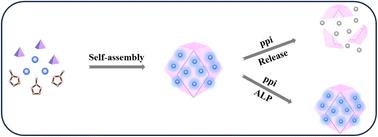当前位置:
X-MOL 学术
›
Anal. Methods
›
论文详情
Our official English website, www.x-mol.net, welcomes your
feedback! (Note: you will need to create a separate account there.)
Capsulation of EBTAC into ZIF-8 for the development of a signal-on fluorescent biosensor to detect alkaline phosphatase
Analytical Methods ( IF 2.7 ) Pub Date : 2023-10-24 , DOI: 10.1039/d3ay01558k Shanshan Liu 1 , Nian Wang 1 , Li Li 1 , Yi Liu 2, 3
Analytical Methods ( IF 2.7 ) Pub Date : 2023-10-24 , DOI: 10.1039/d3ay01558k Shanshan Liu 1 , Nian Wang 1 , Li Li 1 , Yi Liu 2, 3
Affiliation

|
Diseases such as liver cancer, extrahepatic biliary obstruction and osteocarcinoma are closely associated with the abnormal level of alkaline phosphatase (ALP). Hence, it is essential to develop a convenient assay to detect ALP activity. Herein, a novel signal-on fluorescent biosensor on account of the fluorescence signal of the aggregation-induced emission (AIE) fluorochrome 2,2′,2′′,2′′′-((ethene-1,1,2,2-tetrayltetrakis(benzene-4,1-diyl))tetrakis(oxy))tetraacetic acid (EBTAC) encapsulated zeolitic imidazolate framework-8 (ZIF-8@EBTAC) was designed to monitor ALP. Due to the aggregation-induced emission of EBTAC, the synthetic ZIF-8@EBTAC shows robust fluorescence. Once pyrophosphate (ppi) was added, its complexation with Zn2+ in ZIF-8 triggered the collapse of the ZIF-8 framework, releasing encapsulated EBTAC molecules and restoring to free state, leading to the dramatical decrease in fluorescence. ALP could catalyze the hydrolysis of ppi to phosphate (pi), which is difficult to bind to Zn2+ and has little effect on the fluorescence of ZIF-8@EBTAC. Therefore, with the assistance of the substrate ppi, the ultimate fluorescence of ZIF-8@EBTAC was positively related with ALP activity. The constructed biosensor was able to monitor the ALP activity well from 0.01 to 100 U L−1, and a detection limit of 0.01 U L−1 was achieved. Based on the ability of EBTAC serving as a fluorescent probe with aggregation-induced luminescence properties, this proposed design can be applied to diverse targets and provide new ideas for the establishment of fluorescent biosensors.
中文翻译:

将 EBTAC 封装到 ZIF-8 中,用于开发检测碱性磷酸酶的信号荧光生物传感器
肝癌、肝外胆道梗阻、骨癌等疾病与碱性磷酸酶(ALP)水平异常密切相关。因此,开发一种方便的检测方法来检测 ALP 活性至关重要。在此,基于聚集诱导发射(AIE)荧光染料 2,2',2'',2'''-((ethene-1,1,2,2 -四基四(苯-4,1-二基))四(氧基))四乙酸(EBTAC)封装的沸石咪唑酯骨架-8 (ZIF-8@EBTAC)旨在监测ALP。由于 EBTAC 的聚集诱导发射,合成的 ZIF-8@EBTAC 显示出强烈的荧光。一旦添加焦磷酸盐(ppi),其与ZIF-8中的Zn 2+络合引发ZIF-8框架的崩溃,释放封装的EBTAC分子并恢复到游离状态,导致荧光急剧下降。ALP可以催化ppi水解为磷酸盐(pi),磷酸盐很难与Zn 2+结合,对ZIF-8@EBTAC的荧光影响不大。因此,在底物ppi的辅助下,ZIF-8@EBTAC的最终荧光强度与ALP活性呈正相关。构建的生物传感器能够在0.01至100 UL -1范围内很好地监测ALP活性,并达到0.01 UL -1的检测限。基于EBTAC作为具有聚集诱导发光特性的荧光探针的能力,该设计可以应用于不同的目标,并为荧光生物传感器的建立提供新的思路。
更新日期:2023-10-24
中文翻译:

将 EBTAC 封装到 ZIF-8 中,用于开发检测碱性磷酸酶的信号荧光生物传感器
肝癌、肝外胆道梗阻、骨癌等疾病与碱性磷酸酶(ALP)水平异常密切相关。因此,开发一种方便的检测方法来检测 ALP 活性至关重要。在此,基于聚集诱导发射(AIE)荧光染料 2,2',2'',2'''-((ethene-1,1,2,2 -四基四(苯-4,1-二基))四(氧基))四乙酸(EBTAC)封装的沸石咪唑酯骨架-8 (ZIF-8@EBTAC)旨在监测ALP。由于 EBTAC 的聚集诱导发射,合成的 ZIF-8@EBTAC 显示出强烈的荧光。一旦添加焦磷酸盐(ppi),其与ZIF-8中的Zn 2+络合引发ZIF-8框架的崩溃,释放封装的EBTAC分子并恢复到游离状态,导致荧光急剧下降。ALP可以催化ppi水解为磷酸盐(pi),磷酸盐很难与Zn 2+结合,对ZIF-8@EBTAC的荧光影响不大。因此,在底物ppi的辅助下,ZIF-8@EBTAC的最终荧光强度与ALP活性呈正相关。构建的生物传感器能够在0.01至100 UL -1范围内很好地监测ALP活性,并达到0.01 UL -1的检测限。基于EBTAC作为具有聚集诱导发光特性的荧光探针的能力,该设计可以应用于不同的目标,并为荧光生物传感器的建立提供新的思路。































 京公网安备 11010802027423号
京公网安备 11010802027423号